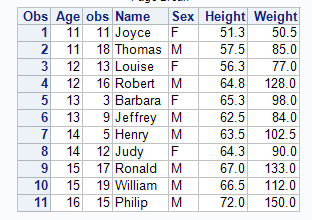- Home
- /
- Programming
- /
- SAS Procedures
- /
- Re: Keep last two observations
- RSS Feed
- Mark Topic as New
- Mark Topic as Read
- Float this Topic for Current User
- Bookmark
- Subscribe
- Mute
- Printer Friendly Page
- Mark as New
- Bookmark
- Subscribe
- Mute
- RSS Feed
- Permalink
- Report Inappropriate Content
Hi
are there any easy way to keep the last
two observations within a group?
Thanks
thomas
- Mark as New
- Bookmark
- Subscribe
- Mute
- RSS Feed
- Permalink
- Report Inappropriate Content
Do you have another variable that controls the sort as well as your group variable?
- Mark as New
- Bookmark
- Subscribe
- Mute
- RSS Feed
- Permalink
- Report Inappropriate Content
Easy? No. But at least it's not terribly lengthy:
data want;
total_count=0;
do until (last.group);
set have;
by group;
total_count + 1;
end;
running_count=0;
do until (last.group);
set have;
by group;
running_count + 1;
if running_count >= total_count - 1 then output;
end;
drop running_count total_count;
run;
Good luck.
- Mark as New
- Bookmark
- Subscribe
- Mute
- RSS Feed
- Permalink
- Report Inappropriate Content
data have;
input group a $ b c;
datalines;
1 A 23 20
1 B 34 32
1 C 29 12
1 D 24 10
2 E 45 65
2 F 87 25
2 G 89 76
;
data want;
set have;
by group;
if first.group then cnt=1;
else cnt+1;
run;
proc sql;
select * from want
group by group
having cnt>max(cnt)-2
order by group,cnt;
quit;
- Mark as New
- Bookmark
- Subscribe
- Mute
- RSS Feed
- Permalink
- Report Inappropriate Content
Consider this PROC SUMMARY.
class age;
output out=last2 idgroup(last obs out[2](_all_)=);
run;

set last2(keep=age _obs:);
array x
if missing(x) then continue;
point = x;
obs = x;
set sashelp.class point=point;
output;
end;
drop _obs: i;
run;

- Mark as New
- Bookmark
- Subscribe
- Mute
- RSS Feed
- Permalink
- Report Inappropriate Content
How about :
data have; input group a $ b c; datalines; 1 A 23 20 1 B 34 32 1 C 29 12 1 D 24 10 2 E 45 65 2 F 87 25 2 G 89 76 ; run; data want(drop=_group); merge have have(keep=group rename=(group=_group) firstobs=3); if group ne _group; run;
Xia Keshan
- Mark as New
- Bookmark
- Subscribe
- Mute
- RSS Feed
- Permalink
- Report Inappropriate Content
Nice! Keep it coming, buddy!
- Mark as New
- Bookmark
- Subscribe
- Mute
- RSS Feed
- Permalink
- Report Inappropriate Content
Here's another option
data have;
input group a $ b c;
datalines;
1 A 23 20
1 B 34 32
1 C 29 12
1 D 24 10
2 E 45 65
2 F 87 25
2 G 89 76
;
run;
proc sort data=have;
by descending group descending a ;
run;
data want;
set have;
by descending group descending a;
retain icount;
if first.group then icount=0;
if icount<2 then do;
output;
icount++1;
end;
drop icount;
run;
proc sort data=want;
by group a;
run;
- Mark as New
- Bookmark
- Subscribe
- Mute
- RSS Feed
- Permalink
- Report Inappropriate Content
Hi,
Problem solved!
Many thanks for all brilliant answers!
/Thomas
April 27 – 30 | Gaylord Texan | Grapevine, Texas
Registration is open
Walk in ready to learn. Walk out ready to deliver. This is the data and AI conference you can't afford to miss.
Register now and save with the early bird rate—just $795!
Learn the difference between classical and Bayesian statistical approaches and see a few PROC examples to perform Bayesian analysis in this video.
Find more tutorials on the SAS Users YouTube channel.
SAS Training: Just a Click Away
Ready to level-up your skills? Choose your own adventure.



